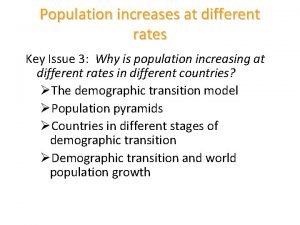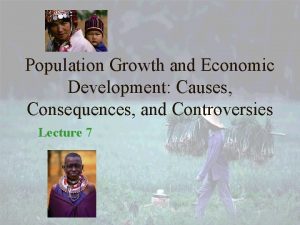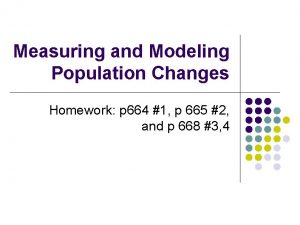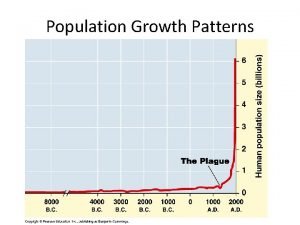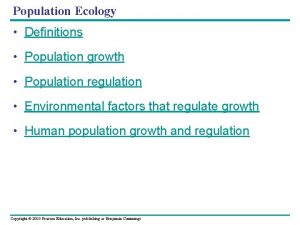Key Issue 3 Variations in Population Growth The

















- Slides: 17


Key Issue 3: Variations in Population Growth • The Main Points of this issue are: – The Demographic Transition • 1. Low growth • 2. High growth – 3. Moderate growth – 4. Low growth – Population pyramids • Age distribution • Sex ratio – Countries in different stages of demographic transition – Demographic transition and world population growth

The Demographic Transition Fig. 2 -13: The demographic transition consists of four stages, which move from high birth and death rates, to declines first in birth rates then in death rates, and finally to a stage of low birth and death rates. Population growth is most rapid in the second stage.

US Population Growth • The United States has moved slightly below Zero Population Growth since 2000. • When most families lived on farms, employment and child rearing were conducted at the same place, but in urban societies most parents must leave the home to work.

Russian Population Growth • Several Eastern European countries, most notably Russia, have negative natural increase rates, a legacy of a half century of Communist rule. • As memories of the Communist era fade, Russians and other Eastern Europeans may display birth and death rates more comparable to those in Western Europe. • Alternatively, demographers in the future may identify a fifth stage, characterized by higher death rates than birth rages and an irreversible population decline.

Demographic Transition in England Fig. 2 -14: England was one of the first countries to experience rapid population growth in the mid-eighteenth century, when it entered stage 2 of the demographic transition.

Population Pyramids • Population in a country is influenced by the demographic transition in two principal ways: the percentage of the population in each age group, and the distribution of males and females. • A country’s population can be displayed by age and gender groups on a bar graph called a population pyramid.

Percent of Population under 15 Fig. 2 -15: About one-third of world population is under 15, but the percentage by country varies from over 40% in most of Africa and some Asian countries, to under 20% in much of Europe.

Young Pop. vs. Older Pop. • Young dependents outnumber elderly ones by 10: 1 in stage 2 countries, but the numbers of young and elderly dependants are roughly equal in stage 4 countries. • The large percentage of children in Sub-Saharan Africa and other stage 2 countries strains the ability of poorer countries to provide needed services.

Changes in the Pyramid • As countries pass through the stages of the demographic transition, the percentage of elderly people increases. • More than one-fourth of all government expenditures in the United States, Canada, Japan, and many European countries go to Social Security, health care, and other programs for the older population.

Population Disparities • The number of males per hundred females in the population is the sex ratio. • In Europe and North America the ratio of men to women is about 95: 100. • In the rest of the world the ratio is 102: 100. • In poorer countries the high mortality rate during child birth partly explains the lower percentage of women. • The difference also relates to the age structure. • Societies with a high rate of immigration typically have more males than females.

Population Pyramids in U. S. Cities Fig. 2 -16: Population pyramids can vary greatly, with different fertility rates (Laredo vs. Honolulu), or among military bases (Unalaska), college towns (Lawrence), and retirement communities (Naples).

Countries in Different Stages of Demographic Transition • No country today remains in stage 1 of the demographic transition, but it is interesting to compare countries in each of the other three stages.

Rapid Growth in Cape Verde Fig. 2 -17: Cape Verde, which entered stage 2 of the demographic transition in about 1950, is experiencing rapid population growth. Its population history reflects the impacts of famines and out-migration.

Moderate Growth in Chile Fig. 2 -18: Chile entered stage 2 of the demographic transition in the 1930 s, and it entered stage 3 in the 1960 s.

Low Growth in Denmark Fig. 2 -19: Denmark has been in stage 4 of the demographic transition since the 1970 s, with little population growth since then. Its population pyramid shows increasing numbers of elderly and few children.

Demographic Transition and World Population Growth • • The Worldwide population increased rapidly during the second half of the twentieth century. The four- stage demographic transition is characterized by two big breaks with the past. – The first break—the sudden drop in the death rate—has been accomplished everywhere. – The second break—the sudden drop in the birth rate—has yet to be achieved in many countries. • • The nineteenth-century decline in the CDR in Europe and North America took place in conjunction with the Industrial Revolution. In contrast, the sudden drop in the CDR in Africa, Asia, and Latin America in the twentieth century was accomplished by different means and with less internal effort by local citizens. Medical technology was injected from Europe and North America instead of arising within the country as part of an economic revolution. In the past, stage 2 lasted for approximately 100 years in Europe and North America, but today’s stage 2 countries are being asked to move through to stage 3 in much less time in order to curtail population growth.
 Key issue 3 why does population growth vary among regions
Key issue 3 why does population growth vary among regions Chapter 2 population and health key issue 3
Chapter 2 population and health key issue 3 Population ecology section 1 population dynamics
Population ecology section 1 population dynamics Section 1 population dynamics
Section 1 population dynamics Population ecology section 1 population dynamics answer key
Population ecology section 1 population dynamics answer key Modeling population growth rabbits answer key
Modeling population growth rabbits answer key Population ecology section 1 population dynamics
Population ecology section 1 population dynamics Rule of 70 in population growth
Rule of 70 in population growth What are the two types of population growth
What are the two types of population growth Population growth curve
Population growth curve Copyright
Copyright Geometric vs exponential growth
Geometric vs exponential growth Why population growth is good
Why population growth is good What is population ecology
What is population ecology Logistic growth ecology definition
Logistic growth ecology definition Milton keynes population 2021
Milton keynes population 2021 Biotic potential
Biotic potential Rule of 70 in population growth
Rule of 70 in population growth
